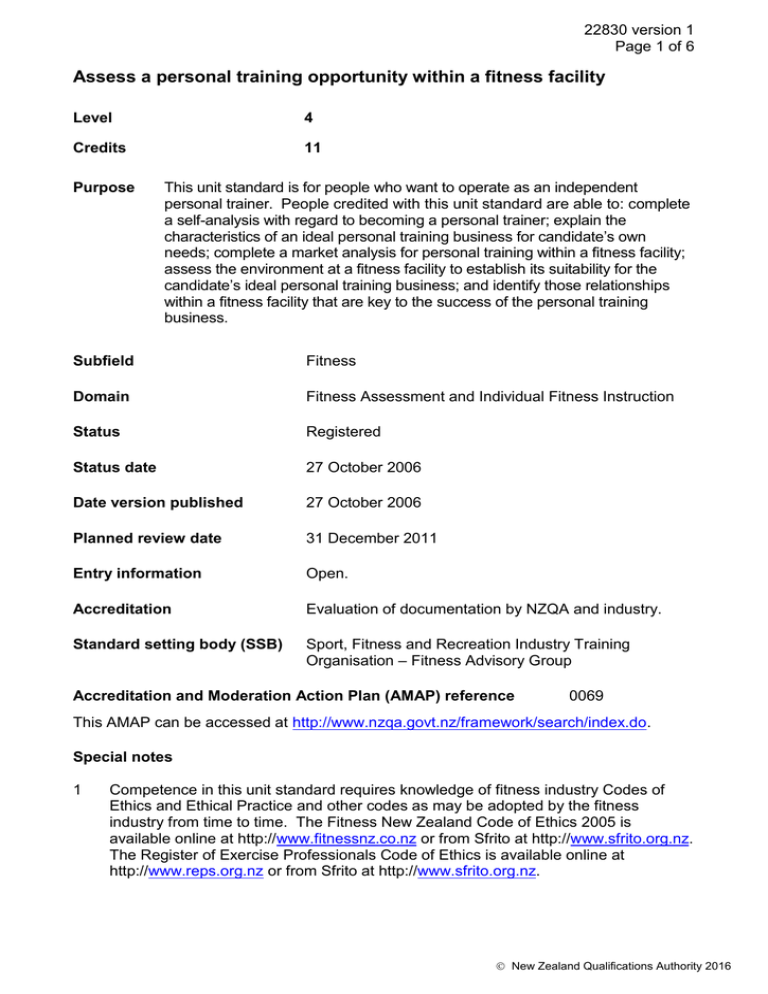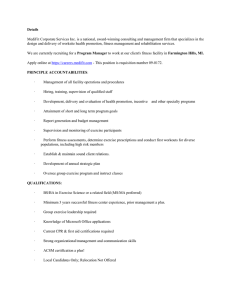Assess a personal training opportunity within a fitness facility
advertisement

22830 version 1 Page 1 of 6 Assess a personal training opportunity within a fitness facility Level 4 Credits 11 Purpose This unit standard is for people who want to operate as an independent personal trainer. People credited with this unit standard are able to: complete a self-analysis with regard to becoming a personal trainer; explain the characteristics of an ideal personal training business for candidate’s own needs; complete a market analysis for personal training within a fitness facility; assess the environment at a fitness facility to establish its suitability for the candidate’s ideal personal training business; and identify those relationships within a fitness facility that are key to the success of the personal training business. Subfield Fitness Domain Fitness Assessment and Individual Fitness Instruction Status Registered Status date 27 October 2006 Date version published 27 October 2006 Planned review date 31 December 2011 Entry information Open. Accreditation Evaluation of documentation by NZQA and industry. Standard setting body (SSB) Sport, Fitness and Recreation Industry Training Organisation – Fitness Advisory Group Accreditation and Moderation Action Plan (AMAP) reference 0069 This AMAP can be accessed at http://www.nzqa.govt.nz/framework/search/index.do. Special notes 1 Competence in this unit standard requires knowledge of fitness industry Codes of Ethics and Ethical Practice and other codes as may be adopted by the fitness industry from time to time. The Fitness New Zealand Code of Ethics 2005 is available online at http://www.fitnessnz.co.nz or from Sfrito at http://www.sfrito.org.nz. The Register of Exercise Professionals Code of Ethics is available online at http://www.reps.org.nz or from Sfrito at http://www.sfrito.org.nz. New Zealand Qualifications Authority 2016 22830 version 1 Page 2 of 6 2 Competence in this unit standard requires knowledge of relevant provisions of statutes including the Health and Safety in Employment Act 1992, Injury Prevention, Rehabilitation, and Compensation Act 2001, Fair Trading Act 1986, Consumer Guarantees Act 1993, Privacy Act 1993 and subsequent amendments. 3 Fitness facilities – refers to any organisation where exercise takes place for the purposes of fitness improvement or maintenance and includes but is not limited to: fitness clubs, personal training studios, recreation centres, and physical rehabilitation clinics. 4 Definitions A lead – is any person for whom the candidate knows their overall goal, current state, timeframes, and reasons for initially taking action. Conversion rate – is the number of leads who accept the offer to become customers/clients divided by the number of leads the personal trainer asks to train with them multiplied by 100. For example, twenty customers divided by forty leads multiplied by one hundred equals a fifty percent conversion rate. Customer or client – refers to any person who is training with a personal trainer and paying in some way for that service. Average spend – is the amount of income divided by the number of customers in a given period. For example, an income of three thousand dollars per month divided by twenty customers results in an average spend of one hundred and fifty dollars per customer. Frequency of spend – is the number of times in a given period the customer completes a transaction with the personal trainer. For example, fifty transactions in a month by twenty customers equates to two and a half transactions per customer. Elements and performance criteria Element 1 Complete a self-analysis with regard to becoming a personal trainer. Performance criteria 1.1 The candidate’s personality traits are analysed and options for managing aspects of their personality to enhance business success are documented. Range 1.2 must include – levels of confidence, self-determination, resilience, attitude to – exercise, business, clients, competition, particular types of work (for example administration, sales, contract negotiations). The candidate’s strengths and weaknesses in knowledge areas related to personal training are analysed and options for addressing any weaknesses are documented. Range must include but is not limited to – exercise physiology, anatomy, fitness testing and exercise prescription, human behaviour, nutrition, promotion and sales, financial, insurance and legal. New Zealand Qualifications Authority 2016 22830 version 1 Page 3 of 6 1.3 The candidate’s strengths and weaknesses in skill areas related to personal training are analysed and options for addressing any weaknesses are documented. Range 1.4 The candidate’s personal philosophy and approach to personal training is recorded. Range 1.5 skills required must include but are not limited to – oral communication, listening, needs analysis, generating and proposing solutions, negotiation, time management, business planning, business administration and risk analysis, teaching and coaching and exercise prescription. must include but is not limited to – their personal values (for example trust, integrity, honesty); how they want to operate (for example in line with their values or will they compromise); where they want to set up (in an environment that is a good ‘fit’ with their values or anywhere there is a ‘good’ opportunity). Given the candidate’s assessment of their skills, knowledge and personality, the opportunities and risks involved in starting a personal training business are summarised. Element 2 Explain the characteristics of an ideal personal training business for candidate’s own needs. Performance criteria 2.1 The profiles of two preferred client groups or target markets are described in terms of client characteristics and client behaviours. Range 2.2 client characteristics include but are not limited to – goals, attitudes, frequency of sessions, level of independence; client behaviours include but are not limited to – how they respond to trainer, how they respond to training, what they say about the training to others. The outputs the candidate would like from their business are explained. Range must include but is not limited to – net financial returns (break-even and best case based on costs and financial goals – including debt servicing and savings), opportunities (for example travel, professional development, personal development), lifestyle (for example spare time, standard of living). New Zealand Qualifications Authority 2016 22830 version 1 Page 4 of 6 2.3 The inputs expected for the candidate’s business are explained. Range must include but is not limited to – contact hours, non-contact hours, appointment times (for example only between 7am and 7pm and no weekends), own training time (days and durations), number of working weeks per annum, stress levels, capital requirements, ongoing financial commitments (in the form of overheads and contingent liabilities). Element 3 Complete a market analysis for personal training within a fitness facility. Range evidence is required for two target markets. Performance criteria 3.1 The target market is profiled in terms of demographics, psychographics and geographics. 3.2 The target market size is analysed in terms of the number of potential clients available to the candidate that fit the target market profile. 3.3 The target market accessibility is analysed in terms of the candidate’s opportunities to promote to potential personal training clients. Range 3.4 Existing supply to the target market is analysed in terms of the services provided and their strengths and weaknesses. Range 3.5 must include but is not limited to – access by email, radio, in person, through referral, through print media, by telephone. may include but is not limited to – current personal trainers working within the market and their characteristics, behaviours, strengths and weaknesses, other sources of services and their characteristics, strengths and weaknesses. Suitability of target market for candidate’s business expectations and current abilities is analysed to establish the viability of the opportunity. Range must include but is not limited to – target market size, ability to purchase, existing supply, accessibility, candidate’s expected business outputs and expected business inputs. New Zealand Qualifications Authority 2016 22830 version 1 Page 5 of 6 Element 4 Assess the environment at a fitness facility to establish its suitability for the candidate’s ideal personal training business. Performance criteria 4.1 The structure of the relationship offered by the fitness facility is assessed for its suitability against the candidate’s business needs. Range 4.2 The operations of the fitness facility are analysed and assessed for suitability against the candidate’s potential business needs. Range 4.3 must include but is not limited to – contract obligations for example rent costs, setup costs, ongoing operational costs incurred such as uniform renewals, potential for rental changes, expected performance and behaviour, termination clauses, disclosure requirements; contract provisions – for example holiday weeks, initial rental relief, facility access, member and database access, equipment maintenance and renewal, professional development opportunities, club opening hours, weekly and annual close down periods or restricted hours, monitoring and control of trainer number and growth, initial leads provided, ongoing referral systems, marketing and promotional exposure, access out of hours, access to internet, printing, photocopying, rights of access for non-member introduction and ongoing training, rights to sell or assign business and license to operate, enforcement of minimum standards on other trainers, options to terminate contract including notice periods. must include but is not limited to – facility’s established policies and procedures – for example sales process, club safety procedures, staff induction processes, new member induction processes, client monitoring and client support activities throughout membership term, opening and closing times, emergency plans and provisions; organisational chart – for example role definitions, lines of accountability/reporting, ability to change processes/procedures; communication – for example the frequency of contact between staff and management, formal and informal meetings, staff functions. The culture of the fitness facility is analysed and assessed for suitability against the candidate’s personal philosophy and approach. Range may include but is not limited to – current personal trainers experiences, staff experiences, member experiences, non-member impressions of the actions of stakeholders and members of the organisation that indicate the general values and beliefs within the organisation. New Zealand Qualifications Authority 2016 22830 version 1 Page 6 of 6 Element 5 Identify those relationships within a fitness facility that are key to the success of the candidate’s personal training business. Performance criteria 5.1 Roles and responsibilities in the fitness facility are analysed to identify key people who can influence the success of the candidate’s personal training business. 5.2 How key people in the fitness facility can influence the success of a personal training business is analysed and described in terms of the actions that they may take. 5.3 The needs, aspirations and perceptions of key people in the fitness facility are analysed to establish how they may be influenced to promote and support the candidate’s personal training business. Please note Providers must be accredited by the Qualifications Authority, or an inter-institutional body with delegated authority for quality assurance, before they can report credits from assessment against unit standards or deliver courses of study leading to that assessment. Industry Training Organisations must be accredited by the Qualifications Authority before they can register credits from assessment against unit standards. Accredited providers and Industry Training Organisations assessing against unit standards must engage with the moderation system that applies to those standards. Accreditation requirements and an outline of the moderation system that applies to this standard are outlined in the Accreditation and Moderation Action Plan (AMAP). The AMAP also includes useful information about special requirements for organisations wishing to develop education and training programmes, such as minimum qualifications for tutors and assessors, and special resource requirements. Comments on this unit standard Please contact the Sport, Fitness and Recreation Industry Training Organisation Limited info@sfrito.org.nz if you wish to suggest changes to the content of this unit standard. New Zealand Qualifications Authority 2016

